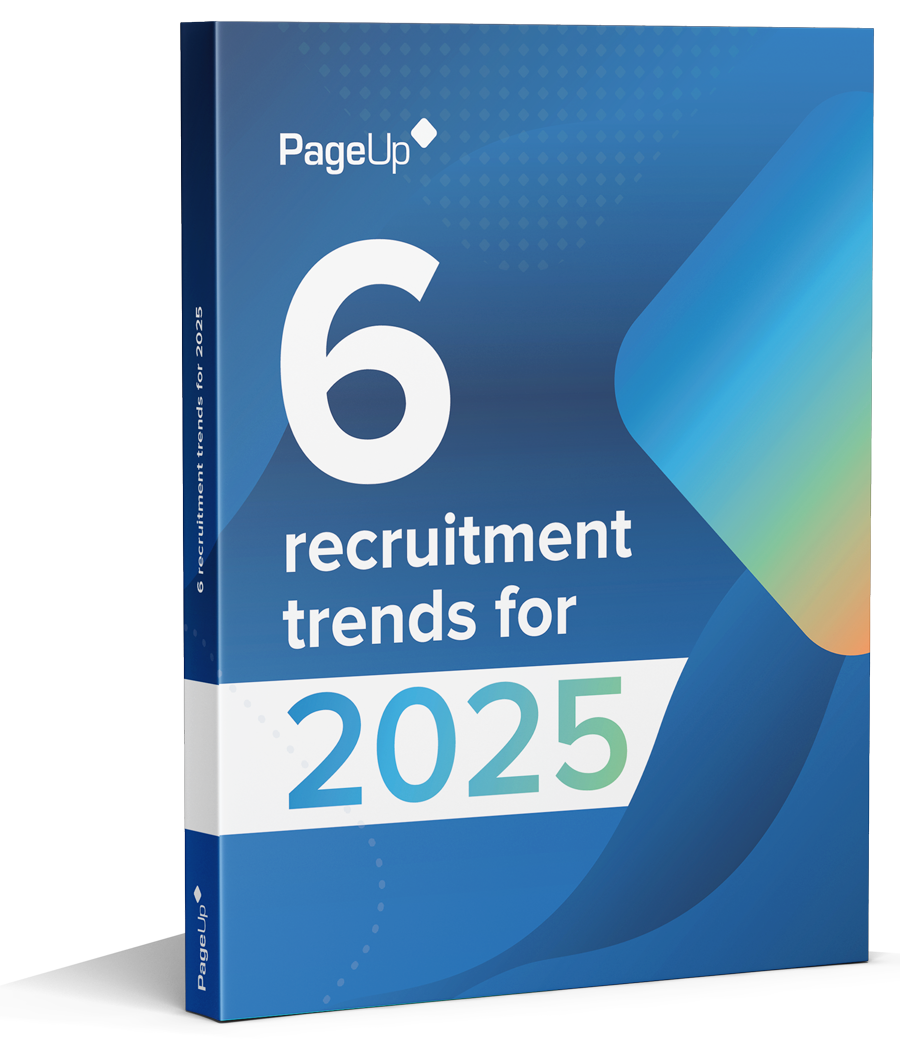2023 Recruitment Trend 1: Recruiters think like marketers

Perhaps the biggest shift in 2023 will be the way we think about recruiting. Talent teams can no longer afford to think like traditional “HR” teams. In order to attract talent, successful recruitment teams have turned to using marketing strategies to proactively draw applicants in.
Recruitment marketing allows you to attract, engage, nurture and convince great jobseekers to apply for a role or express interest in your organisationorganization. It’s about using all the tools at your disposal: careers sites, social media, employee stories, job ads, employer branding, SEO and automation to deliver a personalisedpersonalized experience that paints a compelling picture of life at your company.
In a nutshell, recruitment marketing shows jobseekers why they should want to work for you —which allows you to attract more applicants and build a strong pipeline of talent. Instead of “going fishing” every time you have an open role, you’ve got a shortlist of qualified candidates at the ready. What’s more, it allows you to segment talent into separate nurture pools to target specific cohorts with tailored communication.
This is a new world for many HR teams. Creating content and building website landing pages isn’t what most people think of when they consider pursuing a career in HR. But, with competition for talent at an all-time high, exploring new ways of doing things is the path to winning candidates.
Content plays a major role in recruitment marketing. Jobseekers needs vary widely across industries and demographics. By taking a targeted approach, hiring teams can create content to that speaks directly to their key talent segments. With targeted calls-to-action to drive jobseekers to hit ‘apply’, talent teams can use content to build out pipelines for their hard-to-fill roles.
Once you’ve got your content, focus then turns to distribution. With the explosive growth in user-generated content and apps like TikTok, companies need to adapt their communication strategies to meet jobseekers where they are. Gen Z and millennials in particular are heavy users of social media for careers research —so posting a job ad on a job board might not produce the applications you’re after. But a short-form video, featuring your employees sharing why it’s great to work for your company? Much more compelling to that audience.
Recruitment marketing boils down to showing the right message, to the right people, at the right time, in the right place —and presenting a cohesive picture of your employer brand across all channels. This is a huge shift away from traditional hiring strategies, but it works. And, there are plenty of tools available to help you execute your strategy easily and without increasing your workload.
Using recruitment marketing, Sportsbet was able to see the following results:
400%
increase in referrals
550
applications via careers site
-13
days reduction in time
1/2
halved agency spent in 6 months
They achieved this by using recruitment marketing strategies:
- Building an on-brand, engaging careers site
- Driving traffic back to their site via social media
- Targeted CTA’s
- Employee ambassadors and employee-generated content
- CustomisedCustomized landing pages that speak to each talent segment
- Content that showcases their EVP and resonates with individual talent groups
In 2023, the hiring teams that succeed will use recruitment marketing strategies to boost their talent pipelining strategy, with targeted messaging across multiple channels.
Do:
Think outside the box. Break down your key talent segments and think about what really matters to them, and construct your content and EVP messaging around that.
Use Targeted calls to action and customisedcustomized landing pages for specific talent segments (engineers, data scientists, referral networks, alumni or ex-employees) on your careers site.
Create a pipeline of talent, and use recruitment marketing tools to nurture jobseekers through your recruitment funnel.
Use your careers site as a hub for all your recruitment marketing activity. That way, you can track what’s working, and what’s not and fine-tune your strategy.
Don’t:
Post an ad to a job board and call it a day.
Rely on manual processes to build your talent pipeline —it’s resource-intensive and often delivers a poor candidate experience.
Be generic. In 2023, it’s about standing out from the crowd. Today’s jobseeker asks “Why should I want to work for you?” With 75% of talent not actively looking for a job, it’s up to your recruitment marketing efforts to convince them that your organisationorganization is a great fit for them.
2023 Recruitment Trend 2: Look beyond talent acquisition to internal mobility and ex-employees
Traditionally, HR teams would think of the talent journey as a linear lifecycle: we’d bring new talent in through external acquisition, onboard and develop that talent, then, when it was time to move on, bid them farewell and show them the door. Now, the talent lifecycle looks more circular, and that door has become a revolving door. Ex-employees can be brought back onboard, and internal talent can fill skills gaps.
With many organisationsorganizations looking to rebuild their workforce, but operating in a highly competitive market and with limited budget, HR teams are looking beyond acquisition. They’re instead taking a holistic view of talent that incorporates internal employees and ex-employees (also known as alumni). By taking the focus away from external attraction, organisationsorganizations can save on sourcing costs and hire culturally-aligned, pre-vetted talent.
Internal mobility strategies have been notoriously difficult for organisationsorganizations to do well. But, in changing times, it is essential to look inward and maximisemaximize your workforce potential. Internal mobility is high-ROI: an average of 9X more effective than job boards in producing hires. It takes just 4 internal applications to result in 1 successful hire. These internal career pathways look different to each company: it could include lateral moves, upwards mobility, or cross-functional training and development.
One of the biggest drivers of employee engagement —especially in the millennial generation —is career development opportunities. Careers now are “squiggly”: they no longer look like moves up and down a ladder. Instead, they meander, and it’s important for companies to offer internal mobility opportunities that support their employees to pursue their interests. If they don’t, they risk losing them to companies that will.
These squiggly career paths have brought about a rise in “boomerang employees” —those who leave a company, but come back. In a tight talent market, these ex-employees can hold incredible value. They come up to speed faster, hold institutional knowledge and understand the culture and values of the company.
Insightful recruiters realiserealize that the talent journey is now fluid —ex-employees can be brought back onboard, and internal talent can be redeployed to fill skill gaps.
Do:
Focus on skills over experience. Think laterally and redeploy your talent to avoid laying off team members where possible.
Build a culture of internal mobility —make it a prominent part of your company’s values. Showcase internal opportunities on your careers site and all internal communications channels.
Build an alumni network to stay in touch with ex-employees. You never know when the perfect opportunity may come up to welcome them back.
Use targeted calls-to-action on your careers site —create pages for internal mobility and ex-employees that houses content that speaks directly to them.
Don’t:
Think about career paths as linear, one-way journeys. Let your employees drive their own development and encourage them to explore new interests and opportunities.
Exclude ex-employees from your talent pools.
Don’t let managers “hoard talent”. This is where internal mobility strategies often fail. People are people, not commodities to covet!
Did you know? Using an alumni networking strategy, Flight Centre was about to hire 86 alumni employees in their first three months. The team saved $35,000 per hire using Recruitment Marketing to engage their ex-employee community. Want to find out more?
2023 Recruitment Trend 3: ‘People-first’ employer branding
The importance of employer branding is not news to anyone in the HR space. But, there has been a huge shift in what’s resonating and what’s not. This shift will have a direct impact on your ability to attract and win talent in 2023.
Companies are building “people-first” employer brands: putting people at the centre of their decisions. They are thinking about what their target target segments want from an employer, and beyond that, they empower their people to contribute to building the employer brand. Company cultures that focus on celebrating individual differences and showcasing inclusiveness are coming out on top.
A good employer brand acts like a beacon —it draws people in. But, leading employer branding teams go one step further. They use targeted EVPs to draw in the specific types of talent they want to hire. This might include dedicated career site pages for LGBTQI+ or Women in STEM candidates, or pages catered to tech talent. These pages show specific content that would appeal to these segments, including unique EVP callouts and proof points..
To support this activity, it’s important to really think about what types of content your target talent segments want to see. Our data shows that most commonly, jobseekers are looking for:
- Employee stories and testimonials
- Ways to understand the organisationorganization‘s culture and values
- Information on benefits: flexibility, remote working etc.
- Diversity and inclusion
- Leadership / Mission statements
Tip: 85% of visitors land on your career site via a job page, not your homepage. Ensure you’ve got content that promotes your EVP on all job listings.
When it comes to telling the story of the employee experience at your company, innovative hiring teams are seeing success with employee-generated content. Videos and images, when created by the employees themselves, are the most trusted sources of information —they provide a direct window into life at your company.
This provides you a great opportunity to show that you “walk-the-walk”, showcasing your diverse and inclusive workforce —and allowing candidates to see themselves reflected in your team. Authenticity is key in building a trusted, well-received employer brand —and sharing your employees’ stories is a great way to share valuable content, while building trust with your target talent segments.
Diversity, equity and inclusion (DE&I) practices should form a core part of your employer brand. DEI has become a central focus for HR teams in today’s competitive talent landscape. More than 75% of jobseekers state diversity is an important factor for them when evaluating companies and job offers. And 39% of candidates reject a role or do not proceed with a job application due to a perceived lack of inclusiveness within the organisationorganization.
In 2023, most talent will be passive —meaning they aren’t actively looking for a new role. So, it’s up to employer brands to do the heavy lifting and showcase why your company is the perfect next step for them to take.
Did you know that having a strong employer brand strategy can help drive referral hires? After updating their EVPs and their career site, Sportsbet saw an increase in referral hires of 400%.
Do:
Use authentic employee stories to build your employer brand and give jobseekers the information they are looking for. Today’s candidate wants to see and hear stories from people that they can relate to. Showcasing “people like me” stories on career sites helps candidates visualisevisualize themselves working at your organisationorganization.
Highlight your diverse culture on your company channels and create targeted landing pages to appeal to diverse candidate segments.
Don’t:
Stick to “polished” communications. In the sea of information candidates are searching through, it won’t stand out.
Have one blanket EVP for all target segments. Think about what content will appeal to each of your target audiences and create specific landing pages to support.
2023 Recruitment Trend 4: Candidates are saying “no”

With jobseekers in control, talented people know they can be picky. This means they aren’t afraid to say “no” to offers — in fact, candidates are 66% more likely to say “no” to an offer in 2022 compared to before the pandemic. So, how can your organisationorganization convince them to say yes? By providing a great candidate experience.
49% of jobseekers would reject a job offer after receiving a bad candidate experience.
It’s important to deliver a seamless experience at every touchpoint of your hiring journey. If a job application process is too hard, many people simply won’t complete it. While in times past, this was considered a way to encourage unsuitable candidates to self-select out, now it’s a great way to lose quality talent. In such a tight market, the focus now must be on reducing barriers to entry.
For example, 54% of Gen Z won’t complete a job application if they feel your recruiting methods are outdated. And 46% of them have applied for a job on their mobile . Make it easy to apply for a role on any device —it leaves a great first impression.
In the following stages of the recruitment process, it’s about providing access to the information that jobseekers are searching for. Not only does this give interested parties a great experience, but it allows those who are on the fence to make an informed decision about whether the role is worth pursuing. As we mentioned above, transparency is highly valued in today’s workforce.
Another important factor for candidates is timeliness. With candidates juggling multiple offers, slow hiring processes leave recruiters open to losing a great new hire to a competitor. Jobseekers in 2023 aren’t going to commit to dozens of rounds of interviews, skills assessments and evaluations. To secure the best people, you’ll need to streamline your processes and show candidates that you value their time.
Finally, make sure your candidate communications are personalisedpersonalized and specific. Provide specific feedback in the post-interview stage, and treat the candidate with care and respect —regardless of the outcome. Leading recruiters know that every candidate could one day be a new hire —it’s just a matter of the right role coming up. So, don’t burn any bridges, and leave every candidate feeling valued to retain them as part of your talent community.
78% of candidates say that “Validating that a job is worth pursuing” was important to them. Jobseekers want access to crucial information at the beginning of the hiring process to make an informed decision about whether to continue their application. 70% of Jobseekers said they would be more likely to apply to a position if the ad included a salary range.
Do:
Put people at the centre of your hiring process — prioritiseprioritize their experience throughout the recruitment cycle.
Speed up your time to hire. Good people will get snapped up fast! You can use AI and recruitment automation tools to help streamline your processes.
Be transparent about the role from day one.
Don’t:
Have long, drawn out interview phases. Not only is it a poor candidate experience, but it slows down your hiring time, and you might lose your candidate.
“Ghost” rejected candidates. Provide post-interview feedback and ask them if they’d like to remain in your talent network. You never know when the perfect role will come up!
2023 Recruitment Trend 5: The recruitment tech ecosystem
We sound like a broken record, but we’re hearing it from hiring teams globally: the need to do more, with less resources. Recruiter workloads increased 28% last year compared to pre-pandemic —with no signs of slowing down.
So, savvy hiring teams are turning to tech to help. With the right tech stack, a lean team can realiserealize incredible productivity gains —and thanks to in-depth analytics, they’ll have the metrics to prove ROI.
The ‘gold-standard’ tech stack is a fully integrated, well-oiled machine. Large “all-in-one” ERP solutions are losing relevance, as they lack the flexibility to meet the exact unique needs of each organisationorganization. Instead, teams are shifting to an integrative ecosystem of leading point solutions.
Some HR tech stacks include solutions for AI skills matching, chatbots and candidate screening, others include video interviewing, I-9 verification and background checking software. By choosing leading software that integrates seamlessly, teams end up with the perfect, customisedcustomized tech stack for their company’s needs.
These tools can’t replace the need for recruitment teams. But, they go a long way in making hiring easier in tight markets. This tech can nurture candidates, build out talent pipelines, speed up screening processes and enable remote hiring across the globe. It helps lean teams to provide a great, personalisedpersonalized candidate experience —at scale.
Do:
Seek out your “perfect” tech stack. Take time to evaluate your goals, and investigate what options are available to help relieve your biggest pain points.
Choose tools with lots of integration options. This will future-proof your tech stack as your business needs change.
Don’t:
Rely on manual processes —a recruiter’s time is worth too much to spend on tasks that can be automated.
2023 Recruitment Trend 6: Onboarding that goes above and beyond

In 2023, we expect to see a seismic shift in the importance of onboarding. A new hire’s first few weeks and months with a company should set them up for success —and immerse them in your employer brand. Over 20% of turnover happens within an employees first 45 days with a company. With the costs of acquiring talent skyrocketing to more than $23,000 per hire, this level of churn can have a huge impact on ROI and your bottom line.
There are three factors that will be particularly important to onboarding successfully in 2023:
Onboarding goes beyond the first week
- We’ve seen a change in the perception of what “onboarding” is. Traditionally, onboarding and orientation were thought of synonymously —and onboarding could last a week or less in some companies. Now, onboarding is a more drawn-out process. It’s less about compliance and box-ticking, and more about getting a new hire engrossed in the team, the culture, and their role. Now, strategic HR teams are pushing out onboarding milestones to 6 months or more.
- The competitive talent market has brought about a new trend of “quick quitting” —where new hires leave a role within 12 months in pursuit of a new opportunity. To overcome this, it’s crucial to dedicate adequate time in the onboarding period to really ensure the new hire is aligned with company values. Early exposure to development and internal mobility opportunities goes a long way in retaining talent. The job market is moving faster: Companies need to shift their practices to focus on retention and employee engagement, starting from day one.
Cross-boarding
- We’ve mentioned that internal mobility will be an important strategy for hiring teams in 2023. But, often employees who move into a new role within the same organisationorganization receive little to no onboarding, despite being new to their role. While there will be a certain level of institutional knowledge carried over, a lack of cross-boarding process sets new team members up to fail.
- The best talent teams establish cross-boarding processes in alignment with onboarding. They set up clear 30, 60 and 90 day expectations, as well as key milestones and frequent check-ins to ensure the new team member is settled, supported and ready to succeed.
Onboarding remotely
- Remote onboarding isn’t a new challenge. In the post-COVID world, it’s become commonplace for team members to work in hybrid or remote arrangements. But, many organisationsorganizations still aren’t getting the remote onboarding experience right, which leads to high turnover, burnout and disengaged team members.
- When onboarding remotely, more care needs to go into getting a new team member bought into the company culture. It’s crucial to set aside time to build rapport between team members: there is no “water-cooler” to instigate casual conversion, so teams must construct opportunities to build real, trusting relationships. Research shows that culture is the most important factor in job satisfaction. Prioritising this is essential in reducing turnover.
- The best organisationsorganizations start onboarding the moment an offer is accepted. 51% of candidates continue to apply for roles after recieving an offer. But, regular communication prior to their start date can establish a positive relationship, and reduce the likelihood of your new hire looking elsewhere.
Do:
Ensure internal hires going into new roles are supported with a solid cross-boarding process.
Especially in remote or hybrid onboarding, dedicate sessions to building relationships between key team members.
Set up clear and realistic expectations for your new hires, with regular milestones for month one, three, six and 12.
Don’t:
“Set and forget” your new hires. Give them a clear plan and encourage regular check-ins.
Confuse onboarding with orientation. Onboarding is about setting your new hire up for success, orientation is about introductions and compliance factors.
Skip talking about internal mobility opportunities and development because the team member is “too new”. If they can’t see a future with your organisationorganization, you may lose your new hire to quick quitting.
2023 Recruitment Trend 7: HR earns a seat at the decision-making table
While many businesses already see the value in HR teams, there are some that still see HR as administrators or “order-takers”. During the pandemic, HR leaders within organisationsorganizations were shot into the forefront, with a wave of new challenges. Now, with many businesses facing talent shortages —whether due to layoffs or having no applicants — being strategic with your headcount has never been more important.
HR has become a key influencer of overall company strategy. Beyond simply filling roles, HR is building the workforce of the future, influencing culture and employer branding, and enacting flexible working models. Now, HR plays an integral part of solving organisationalorganizational problems, projecting future needs, and enabling growth in line with business objectives.
This need for HR’s input and insights on bigger picture business strategy has forced all organisationsorganizations to see HR for what they truly are: a key partner in the organisationalorganizational machine. In 2023, hiring teams will need to prove they can be strategic, provide support to redeploy talent, maximisemaximize internal resources, and show ROI on their activities.
While this shift will change the dynamic of many talent teams, it’s a shift that needs to happen. With HR taking a seat at the table, businesses can get more out of their teams, have a highly engaged workforce, and boost their bottom line —even in times of change.
Do:
Build strong business cases for activities using case studies and metrics to show ROI.
Automate processes where possible to focus on strategic decision-making.
Show long-term thinking by building talent pipelines, following market trends and anticipating future talent needs.
Don’t:
Ignore the changing role of HR and talent acquisition teams. While some businesses are shrinking headcount, the fluid and evolving nature of the talent market will mean that the knowledge and skillsets found within TA teams will always be needed.
2023 Recruitment Trend 8: A cultural shift to flexible work
Hybrid and remote work is here to stay. Yet there continues to be a back and forth between more traditional executives and what employees and jobseekers are looking for. 95% of executives believe being in the office helps to promote culture, while 34% of employees said they would look for a new role if their employer didn’t offer remote work options. So how will organisationsorganizations navigate this in 2023?
Tip: Today’s jobseekers value transparency. When hiring, be open about your expectations and opportunities for remote or hybrid work. That way, candidates can make informed decisions about whether what works for your company will work for them.
Research indicates that 60% of jobseekers are looking for remote working options, while only 30% of advertisedadvertized jobs are listed as remote roles. This provides an opportunity for hiring teams to bridge the gap, and realign their EVP with the current market.
Some teams are instituting “work from anywhere” policies which, in contrast to WFH, allow employees to work from anywhere in the world, across any timezone. Heralded as the ultimate in flexibility, these policies also provide great content for companies to share to bolster their employer branding efforts. Jobseekers can hear testimonials from employees working from Fiji, which paints a nice picture of life at the company.
The other key shift we are seeing with remote-first workplaces is the shift from “time served to impact delivered” —or, shifting towards an outcomes-based model of working. Remote workers are free to structure their day as they choose, so long as they meet their key deliverables.
There are some key challenges linked to having a remote workforce. Building culture is the most commonly referenced, next to increased levels of burnout, and employees being “unable to disconnect”. With people firmly sat in both camps the consensus seems to be: people want the option to do what works best for them. What is HR’s role in 2023? To be aware of the challenges, and proactively support employees to overcome them.
Do:
Ensure you’ve got the right tech stack to enable remote work.
Find ways to connect and build a company culture outside of physically meeting.
Have online connection events, awards ceremonies and get your employees involved in building your employer brand.
Encourage employees to “switch off” and take breaks regularly.
Be clear about your expectations surrounding hybrid or remote work from the start.
Don’t:
Equate culture with physical presence. While connecting in person is a great way to build relationships, remote-first and hybrid teams need to be creative and build culture in other ways.
2023 Recruitment Trend 9: Data-driven decision making
For many teams, budgets and headcounts are shrinking, while workloads are rising. In 2023, ROI and finding process efficiencies are going to be key to success. How? Through metrics.
Savvy hiring teams use data to drive their decisions. Having measurable proof points helps when building a business case for new technology, new processes or requesting additional funding for much-needed projects. In 2023, with businesses cutting down on unnecessary spending, every decision will need to be backed by clear supporting data.
How are these teams using data in their processes? It starts by setting the right KPIs. Think about the core things you need to achieve. Are you looking to increase internal mobility? Consider a KPI around internal hires. Are you looking to increase your offer acceptance rate? Perhaps introduce KPIs that support a quicker time to hire. Don’t introduce too many KPIs at once —but choose the most important goals and establish targets around that.
Having clear goals can also help you maximisemaximize the effectiveness of your channels. For example, if you can see that your careers site is getting a lot of traffic, but you’re not getting applications, you may need to review your job listings to ensure they are relevant and engaging to your target talent segment.
*See how Mater hospital uses metrics to supercharge their hiring: using analytics, they improved LinkedIn’s sourcing channel effectiveness from 3% to 20%.
Why use data?
- Faster time to hire
- Increase channel effectiveness
- Reduce hiring costs
- Reduce bias in hiring processes
Do:
Take advantage of the analytics available in your tech stack.
Choose recruitment technology solutions that provide deep data and analytics insights.
Establish a baseline to measure progress against.
Research and set benchmarks to work towards.
Set clear achievable goals and measure your progress towards them regularly.
Don’t:
Over-KPI. While data is great, tracking too many numbers can dilute the importance of the core few that really matter.
2023 Recruitment Trend 10: Retention is your best recruitment strategy

In 2023, retention will be even more strategically important than recruitment. As a result of the ‘churn and burn’ mentality adopted by many high-growth companies, recruiters are now finding that the pool of available talent is drying up. The most successful organisationsorganizations prioritiseprioritize retention, employee engagement and internal mobility —and as a result, rely less on external recruitment.
The past few years, the term “hustle culture” has run rampant in the younger generations. “Hustle culture” puts hard work on a pedestal —and demonisesdemonizes the idea of rest.
But in the aftermath of the pandemic and the economic changes that have followed, 52% of workers are facing burnout, and the “hustle” is no longer idolisedidolized. Instead we’ve seen the rise of a new phenomenon in millennials and Gen Z: quiet quitting.
While quiet quitting sounds dire, when broken down, it’s people just doing the standard required from their jobs. Instead of pushing to go above and beyond, quiet quitters are doing what is in their job description, and nothing more.
Many have called out quiet quitters as lazy or entitled. But what quiet quitting really represents is much more troubling than a group of workers who “can’t be bothered”. It represents a workforce in crisis, and leaders who haven’t yet acknowledged the problems.
It’s easy to misjudge the intentions behind quiet quitting, but at its core, it shows a misalignment between a business and its employees. The employees are feeling burnt out and disengaged, so instead of going above and beyond, they’re choosing to do only the tasks as narrowly assigned to them in their job descriptions. Workplaces, who have built processes and productivity metrics around the previous framework of “hustle culture” —or their employees going above and beyond —see this as a drop in productivity.
We know that disengagement occurs when there is a lack of purpose and values in the work an employee does. It’s crucial for organisationsorganizations to reflect upon their EVPs, listen to what their employees are looking for, and work towards it. For example, salary is not always the main focus. People generally want meaningful work and to contribute to a larger purpose. Successful organisationsorganizations showcase their inclusive cultures and commitment to DE&I, as well as a genuine focus on tackling social and environmental issues. Flexibility and autonomy are also highly valued by today’s workers. Research shows 34% of employees would look for a new role if their employer didn’t provide remote work options. More than half of working professionals would take a pay cut if it meant they could work from home 100% of the time
In an era where retention is just as crucial as acquisition, talent teams will have additional responsibilities to encourage employee wellbeing and ensure leaders do, too. Organisations that prioritiseprioritize employee engagement will overcome quiet quitting, reduce staff turnover, and ultimately improve their bottom line.
Do:
Take time to understand the values and what’s important to your employees. This will help you to build activities and an EVP that keeps them engaged.
Encourage your employees to focus on wellbeing in the workplace.
Carefully construct job descriptions.
Don’t:
Consider quiet quitting as being lazy. It’s your team members saying they are at capacity. Consider it as an opportunity to better support your employees to find work-life balance.
Are you ready to take control of your recruitment strategy?
To navigate the 2023 talent market you need a strong strategy. Have you got the tools you need to attract and hire great people?
Every day, the PageUp team works with hundreds of clients globally to optimiseoptimize their sourcing channels and career sites, build strong talent pipelines, and nurture relationships with internal and external talent.











